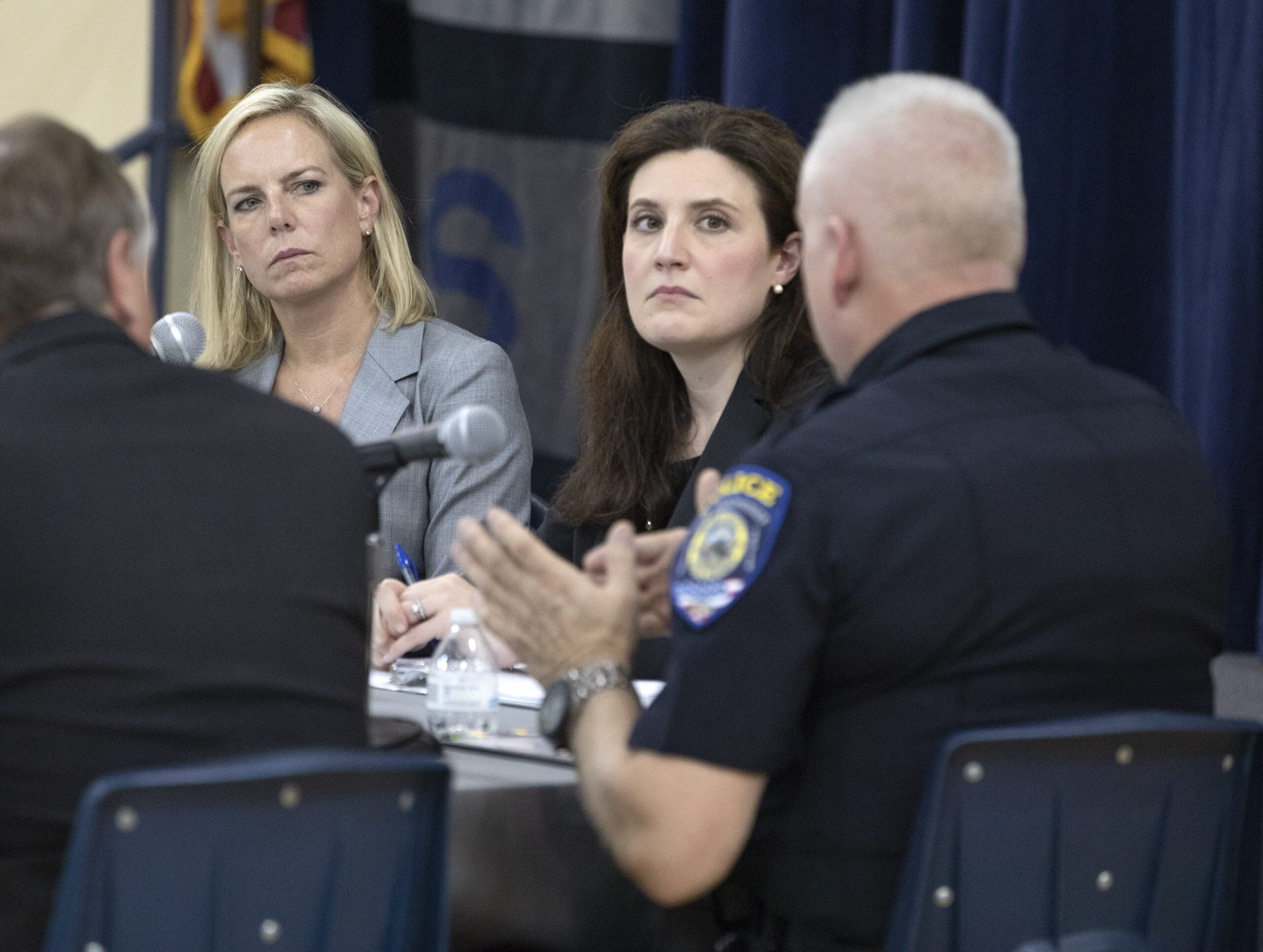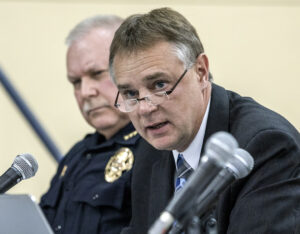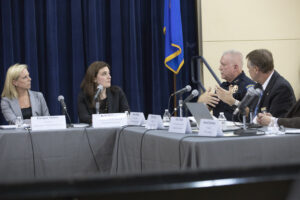Federal school safety panel including Kirstjen Nielsen focuses on design, tech during Vegas trip

On average, mass shootings in American schools last four to six minutes.
And on average, police response times to school shootings take between seven to 12 minutes.
Every second shaved off of that gap could mean lives saved and injuries avoided. For Tim Troyer, an Indiana sheriff who spoke at a federal school safety panel in Las Vegas on Thursday, one of the most important and least realized aspects of school security is basic design and layout of school facilities themselves.

“Very little since the Columbine shooting 19 years ago has changed in our schools,” Troyer said. “The important resources in prevention, intervention, mental health, early identifiers, the list goes on, yet school shootings are increasing. However, protective space has always been at the bottom. It’s time to stop ignoring what’s right in front of everyone’s face and start taking action to protect our nation’s students, teachers and staff.”
Those subjects dominated discussion during the Thursday field trip taken by the Federal Commission on School Safety, which consists of cabinet secretaries including Department of Homeland Security Secretary Kirstjen Nielsen, Education Secretary Betsy DeVos, Health and Human Services Secretary Alex Azar and Attorney General Jeff Sessions. The committee has met several times since being formed by President Donald Trump in the aftermath of the March mass shooting at a high school in Parkland, Florida, and is charged with developing “meaningful and actionable” recommendations to keep schools secure.
Mass shootings make up a small percentage of gun deaths in America, and mass shootings at schools are still relatively rare. But panelists, including Nielsen, said Thursday that their desire was to make schools as safe as possible without, as Troyer put it, “making a school appear or feel like a fortress.”
The listening session took place at what was presented as a prime example of a secure campus — Miley Achievement Center, an elementary, middle and high school in East Las Vegas that primarily serves children with mental illness and behavioral problems. The school is the recipient of a grant from ASIS International — an organization representing “security professionals” — that will allow the school to install multiple security upgrades including a transactional window in the school’s front lobby, improved security cameras and metal detectors, and upgraded radio systems.
“We deeply believe the physical environment of a school is critical in keeping a school safe,” school principal Joanne Vattiato said. “At Miley, we also believe trusting relationships, student and staff engagement, restorative practices and self-care are equally essential.”
A looming fear of gun violence isn’t a stranger to Clark County schools — at least 17 guns were recovered on school district properties last academic year, and this school year has already seen two students arrested over threats of violence, including a 16-year-old who carried a loaded gun onto Green Valley High School’s campus last week.
State officials including Gov. Brian Sandoval and Attorney General Adam Laxalt have also convened panels devoted to studying school safety issues and making recommendations to the 2019 Legislature. Many of their recommendations echoed calls and suggestions, including better coordination between school, local, state and federal law enforcement and emergency response personnel.
Panel topics on Thursday included a local law enforcement perspective on school safety, as well as a presentation on best designs and practices for school building security. Nielsen said it was the fourth trip taken by the commission, and the first one overseen by the Department of Homeland Security.
Suggestions ran the gamut. Among them, replacing classroom doors and windows with ballistic-proof material, connecting school security cameras with 911 operators, and more closely integrating school security resources with local law enforcement.
Troyer suggested that school police be kept as separate as possible from school administrators, including rotating them between schools to keep them focused on security and not on providing a quasi-academic role.
“School officials are not in the business of managing a law enforcement agency, no more than I am in the business of managing teachers in schools,” he said.
Another suggestion included amending fire codes to implement a short waiting period after a fire alarm is pulled, as a mass exodus of students making for an evacuation can exacerbate casualties if an active shooter is still on campus.
Paul Timm, an executive with Facility Engineering Associates, said that schools should seek to include students in the emergency planning process, as they tend to have a better pulse on social media and combating misinformation or “fake news” that professionals may overlook.

But panelists balked at the idea of heavily involving children in training exercises. Clark County School District Chief of Police James Ketsaa said that while the department trains teacher and staff, the cons involved with including children would outweigh the benefits.
“To actually have the kids in the classroom where we come in and show our law enforcement tactics with weapons drawn during training. I don’t think that, unless something is going to change, that we have the appetite,” he said. “You can potentially traumatize your children.”
Speakers shied away from more politically-oriented potential solutions to gun violence in schools, including any sort of gun control and Trump’s suggestion of arming teachers as a way to deter school shootings.
In a brief interview with reporters after the event, Nielsen declined to say if she thought that armed teachers or fewer guns would prevent future mass shootings.
“I think communities are looking at that individually,” she said responding to a question about arming teachers. “As you know, some communities do, some communities don’t, so I think each community has to determine what applies best for them. We’re trying to look more at standards and building security, from a DHS perspective.”
Progressive groups sought to tie Nielsen’s visit to the Trump administration’s now cancelled family separation policy, which the secretary defended during a White House press briefing in July.
“Secretary Nielsen will find that Nevadans do not support policies that seek to divide and discriminate, let alone separate children from their parents,” ACLU of Nevada director Tod Story said in an emailed statement. “If school safety is truly a priority for the Trump administration, then they should recognize that family safety is the first line of defense and keep children with their parents.”
Editor's note: We edited this story at 4:34pm on August 24, 2018 to reflect Miley Achievement Center as an elementary, middle and high school in East Las Vegas.
